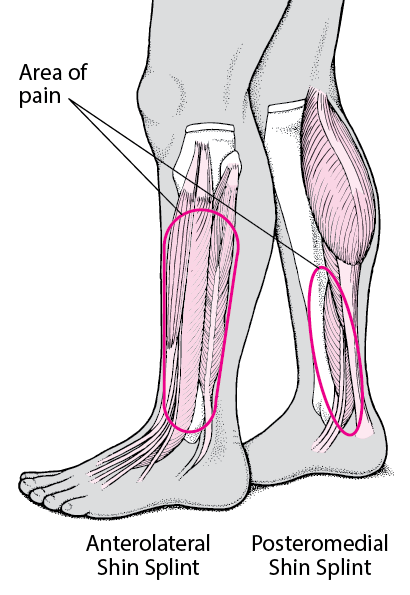Shin Splints is a term used to describe pain felt on the front or inside border of the shin but isn’t an official diagnosis. This pain can be caused by a variety of factors, some of which are more serious than others, so it is critical to have your pain evaluated so that the underlying cause can be identified and treated appropriately.
The most common and treatable cause of shin splints in runners is ‘Medial Tibial Stress Syndrome,’ which is a reaction of the ‘periosteum,’ which lines the medial border of the tibia. There are several theories as to why the reaction occurred, but it is widely assumed to be an inflammatory reaction caused by excessive traction on the periosteum pulling away from the bone. Shin pain can be caused by more serious conditions such as a stress fracture (an incomplete crack through the bone) or compartment syndrome (swelling of muscles within a closed compartment of the lower leg).
Symptoms
MTSS typically manifests as a dull ache along the inner shin border. Both sides are frequently affected. Pain is typically worst first thing in the morning, and it is frequently at its worst at the start of a run, improving slightly as you warm up only to reoccur after you finish. On palpation along the shinbone, there will be generalised tenderness; if there is a sharp pain on one specific point, this may be indicative of a stress fracture. Generalized MTSS frequently progresses to a focal stress fracture.
Pain confined to a single point, worsening pain with continued activity, and reduced pain with rest are all signs of a stress fracture (these will generally feel better in the morning). Stress fractures will only be visible on a plain X-ray if they are severe. Most will only be visible on an MRI or bone scan.
Shin pain from compartment syndrome will appear on the outside of the shin over a more fleshy muscular area. Due to the compromise of neural tissue in the compartment, there may be a sensation of ‘increased pressure’ in the lower leg or pins and needles/numbness. Pain will appear and worsen during a run and will persist after stopping. Compartment pressure testing, which involves inserting a needle into the compartment and measuring its pressure before and after running on a treadmill, can be used to confirm this diagnosis.
Causes
Overloading of the tissues in the lower leg causes all types of shin injuries. MTSS is common in new runners who have not yet adjusted to the stress of running or in runners who rapidly increase their training load. An imbalance between the calf and anterior lower leg muscles may also be to blame, with the calf muscles being overly tight and the anterior muscles being weak. Poor control of pronation of the foot, wearing poorly fitted or worn out footwear, hip instabilities, and training on hard surfaces are all factors that can lead to overload.
Stress fractures can be caused by any of the aforementioned factors and are more commonly associated with osteoporosis or hormonal imbalance in female runners. Overuse, calf muscle tightness, and increased calf size can all be symptoms of compartment syndrome.
Treatment and Prevention
It is always best to see a Physiotherapist at the first sign of any shin pain to identify the source of the pain and allow early management to begin before the condition worsens. I as a physiotherapist have experience diagnosing shin pain and will treat your condition as soon as possible using a holistic approach to ensure all contributing factors are considered.
Self-management strategies for MTSS include icing the painful area, taking anti-inflammatory medication, reducing your training load, running on soft surfaces, and stretching your calves regularly. Soft tissue release, dry needling, and a stretching/strengthening programme are all physiotherapy treatment techniques that can help you recover faster and avoid re-injury.
Stress fractures are not all the same. If you’re lucky, a low-grade stress response in the fibula can keep you from running for as little as four weeks. A tibial stress fracture can be more serious. The inside and posterior borders of the tibia have a high healing capacity, but the front border of the tibia can be one of the worst places for a stress fracture, requiring complete rest with crutches and even aggressive surgery. All stress fractures should be evaluated by a sports medicine specialist, who will not only assist your physiotherapist in managing it correctly, but will also look for underlying causes.
As a result, it is critical to have these conditions diagnosed as soon as possible for the best chance of a full and speedy recovery.

